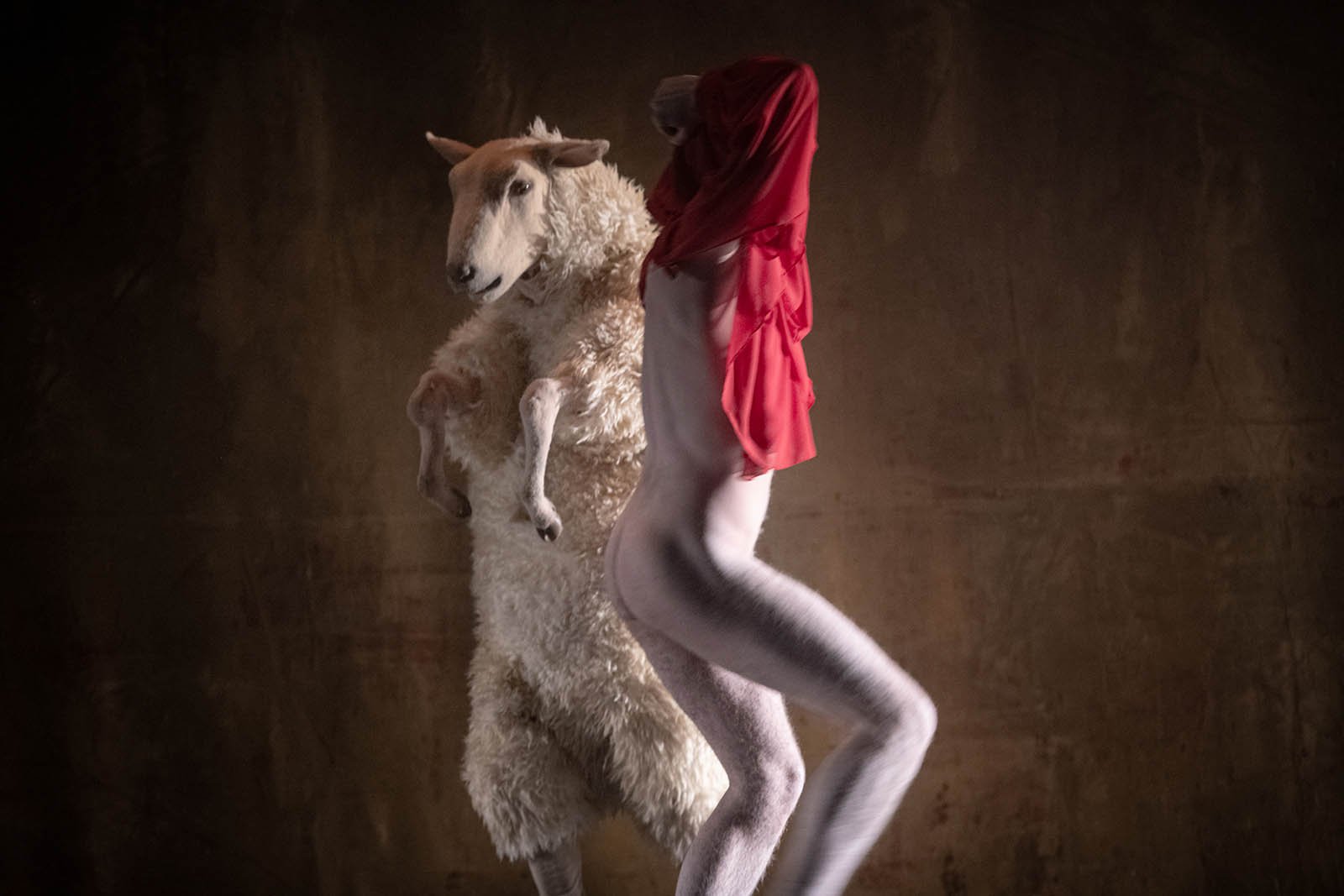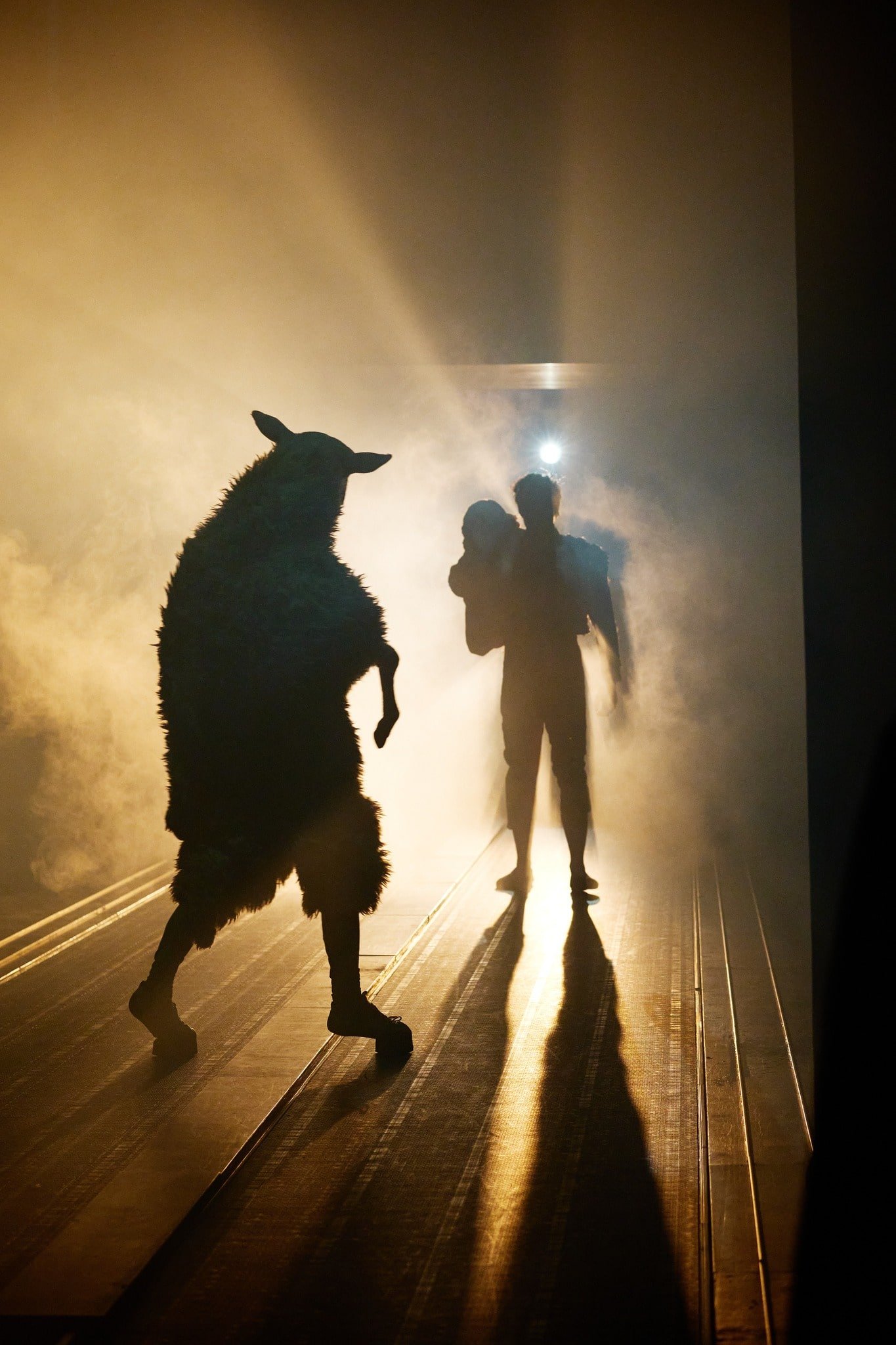The Sheep Song: When a Sheep Seeks to Become Human
In The Sheep Song, Belgian troupe FC Bergman invites us to confront the essence of humanity — its beauty, its struggles, and its longing.
Sense of Wander: ★★★★☆
A sheep striving to become human and a naked man with his face covered in red fabric may appear as opposites at first glance, but a closer look reveals their shared ambiguity of identity and an unspoken yearning for something more. Image courtesy of FC Bergman.
TAIPEI, Taiwan — I didn’t realise at first that a bronze bell had been installed high in the ceiling at the centre of the National Theatre until a performer — his naked body seemingly painted white, his head shrouded in red fabric — rings that bell. The clang lingers in the theatre, reminiscent of a school bell. This marks the beginning of a fable: The Sheep Song, presented by the Belgian troupe FC Bergman.
The scene opens with a herd of sheep grazing, accompanied by the soothing strum of a banjo — a melody that flows throughout the 90-minute play. As the sheep leave the stage one by one, one remains. We watch as it wrestles with its fleece, struggling to get rid of it but failing to do so. Then, it begins to rise, attempting to balance on its hind legs and walk like a human.
The sheep carefully treads across the stage, as if on tiptoe, amidst the flamboyance of the urban city. Image courtesy of FC Bergman.
The sheep steps into the human world, where the entire stage moves like a treadmill, running from right to left as if setting the rhythm for the passing of time. We watch as it carefully treads among men and women in suits and dresses, their faces hidden behind semi-transparent masks.
The sheep follows them, intrigued by their expressions — though puzzled by what it sees — and mimics their gestures. At times, it moves in sync with the stage’s motion; other times, it resists, struggling to stay grounded.
It also encounters their language: two rows of broken letters beautifully slide onto the stage, combining to form the phrase “In ludo monstrorum designatur vanitas vanitatum” in capital letters. Turns out it’s a dictum by Herrad of Landsberg, a 12th-century Alsatian nun, that translates to “Playing unnatural things indicates vanity of vanities.”
Then the sheep arrives at a puppet stand, confronting the lust and absurdity of the human world. The puppet show becomes a fitting metaphor for control, reflecting how our actions — whether conscious or not — are shaped by morals, ethics, and laws. The sheep observes the puppet show from a distance, unaware that the steps it has taken bring it closer to this chaotic world.
The sheep, now wearing a jacket, begins to look more human. Image courtesy of FC Bergman.
One can’t help but wonder how the troupe makes the sheep appear more human, beyond walking on its hind legs and adopting human-like gestures. It isn’t long before we see it wearing a jacket. Then, the sheep-man’s offspring is born and, like a loving parent, he gently swings the baby in his arms, finding ways to comfort its cries.
The naked man rings the bell again — this time, multiple rings echo throughout the space. A cathedral, standing amidst a medieval town and weathering the passage of time, emerges in my mind. It’s as if the clangs serve as a wake-up call to the sheep-man, cautioning him that his journey may lead him nowhere.
The sheep-man, surrounded by a group of surgeons, is stripped of his fleece, revealing a human form — though his head remains wrapped in bandages. Curiously, he carries with him a baby sheep kept in a jar. When he finally removes the bandages, his face is seen masked in the same way as the men and women seen earlier.
Though now human, he can’t fully shed his sheep-like nature. When chased by a group of men in suits, he instinctively climbs to the top of a tree — a response more fitting for a sheep than a man.
At one point, I wonder if the men and women the sheep-man once aspired to emulate are just figments of his imagination — a projection of what he believes humans to be, much like how we, as humans, mould ourselves to fit societal expectations. Why strive to tame himself when he, unlike the barking dog reined in by its owner, is inherently free?
My favourite scene is when the man dances amidst a cityscape illuminated at night. Though he appears physically free, something seems to weigh him down — a yearning for belonging. This struggle isn’t his alone; it’s a shared human experience as we all search for purpose and meaning in life.
After shedding his fleece, the man dances freely amidst the cityscape illuminated in the dark. Image courtesy of FC Bergman.
Finally, we watch the man collapse from exhaustion — but from what? Perhaps it’s the powerlessness of being trapped in the identity he’s created. As he falls off from the stage, he pulls a string and rings the bell.
Suddenly, a natural landscape of mountains and rivers emerges in the backdrop. We hear birds chirping in the distance, and the soft glow of sunrise begins to light up the view.
In this serene scene, the man picks up the banjo that was offered to him earlier but which he had refused. Now, he begins to play, gazing at the landscape. It’s as if, after experiencing the complexities of “human life,” he’s longing for the tranquility that only nature can offer.
In the final scene, the herd of sheep from the opening returns, grazing on stage. The man tries to join them, but the herd keeps running away. He is neither fully human nor sheep. Who is he now?
Without a single spoken word throughout the play, this is where The Sheep Song comes to a close.
This scene from The Sheep Man highlights the play’s immersive, sensory-rich scenography, drawing the audience into its world. Image courtesy of FC Bergman.
So, why did I decide to watch a performance about a sheep — portrayed by a man? I asked myself the same question before coming. But after the play, I think I have an answer — to explore what makes us human through the lens of an animal. After all, what seems like the odyssey of a sheep is really a reflection of ourselves.
The Sheep Song is a fable, though the animals in Aesop’s Fables never seek to become human. The Belgian troupe presents it as a “modern parable,” and the choice of a sheep is no accident as it carries deep religious symbolism. In Christian faith, “the sheep serves as the model for the submissive, obedient human being,” as Stef Aerts explains.
In The Sheep Song, the submissive creature is granted the freedom of will and chooses to become human. However, we never truly know what the sheep thinks throughout its transformative journey — its emotions remain hidden behind its sheep head and the masked human face. This adds another layer of ambiguity to the wordless play, leaving room for interpretation — one that often mirrors our own thoughts.
I’m particularly drawn to a scene where the sheep-man dances with a naked man. At first, they seem like two opposite beings, but a closer look reveals their shared ambiguity of identity and an unspoken yearning for something more.
FC Bergman refers to the play as a “modern parable.” Even after the curtain falls, the lingering question for me is this: does looking human make us human? And, perhaps more importantly, beyond our looks, gestures, language, and actions, what is it that truly makes us human?
While I may never have an answer to these questions, The Sheep Song is a work of visual poetry — its beautifully crafted, sensory-rich scenography feeding our quest for the meaning of existence.
Reference:
Program notes for The Sheep Song. November 29-December 1, 2024. National Theatre, Taipei.
FC Bergman’s The Sheep Song was staged at the National Theatre in Taipei from November 29 to December 1, 2024.





